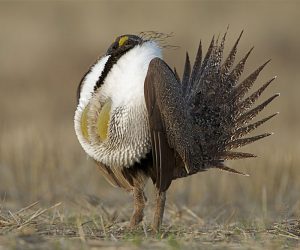The PBS Nature series aired a program on the endangered Sage-grouse on May 20. The natural history of this bird and other denizens of the sagebrush plains was well represented. The documentary even mentioned habitat destruction by oil and gas interests. Very daring of them. And timely. This lovely creature is not only under attack by resource extraction, but also the United States Congress. I wrote an editorial on this subject first printed in The Taos News on May 14:
The United States Senate Committee on Armed Services will be meeting later this month for a “Markup” of The National Defense Authorization Act for Fiscal Year 2016. The bill that comes out of this committee, when reconciled with the version from the House of Representatives and signed by the President, establishes the budget for much of our national defense.
Included in this year’s bill is a special provision for the Sage-Grouse, an endangered (and spectacular) bird that (for now) lives in parts of Colorado and adjacent states to the north and west. Like the EA-18G Growler and the F-22 Raptor warplanes, the sage-grouse can fly. And while it is an effective system for destroying our nation’s insect enemies, it would seem better suited for the Agriculture or Interior Departments than as part of an appropriations bill for the Department of Defense.
The rapidly declining Sage-Grouse (also known as the Greater Sage-Grouse, Centrocercus urophasianus, and its even more endangered cousin, the Gunnison Sage-Grouse, C. minimus) is in catastrophic decline due to habitat loss. They may have once numbered in the millions, but are currently on their way out of existence. Animals and plants is this predicament have in the past found some protection through one of the great pieces of environmental legislation, the Endangered Species Act (ESA) which can help in saving habitat and reducing hunting pressure (while also protecting private property rights).
Instead, this time, the Sage-Grouse has become the latest victim in the culture-war being waged by right-wing politicians against all policies thought by them as “liberal.” As far as I know this Galliforme exhibits not the slightest political inclination, taking no position on the use of missiles or the deployment of aircraft carriers. The male of the species is primarily known for its “dancing,” or mating display. This should find favor with conservatives since the point of the dance is traditional male-female heterosexuality at its finest.
So what is the Sage-Grouse doing hanging out in the same bill with drones and helicopters? Here is where its special status comes about. Republicans have placed this animal on a hit list hidden within the labyrinth of defense spending that specifically exempts the Sage-Grouse from listing under the Endangered Species Act. Without this protection, the Sage-Grouse may be doomed to extinction.This is clever if underhanded: neither Congress nor the President is likely to sacrifice the national defense establishment to save a grouse.
If the Republicans are successful in this they will accomplish two goals. First, habitat that might have been protected to save the Sage-Grouse will not be protected and instead will be open to oil and gas resource extraction. Second, by establishing the precedent of defying the Endangered Species Act, they may also keep other species off the list and could de-listing those already protected. And if they succeed in gutting the ESA, why not move on to similarly decommissioning other environmental protections for clean air and water?
Thus, on the stubby wings of Centrocercus urophasianus, hangs a great weight.
On April 29 I met with Senator Tom Udall, Senator Martin Heinrich and Representative Ben Ray Lujan. I was part of a volunteer citizen group organized by the environmental group, Defenders of Wildlife (www.defenders.org). We discussed with these gentlemen (and their legislative assistants) the ESA, sustainable logging in National Forests, and assuring adequate funding for fighting wildfires. Our legislators were cordial and supportive, welcoming to their constituents from New Mexico. All three of them expressed support both for the ESA. We asked that they try to rescue the Sage-Grouse from being lumped in with defense appropriations.
Whether or not they (with our support!) can save the Sage-Grouse and the ESA is an open question since this legislation has never before been subjected to anything like the current level of attack. That the Endangered Species Act is itself highly endangered was an irony made all the worse when the Sage-Grouse exemption from protection passed through a House committee hearing in the same week when I was in Washington advocating for its protection.
If you care about saving the ESA from extinction (and its feathered, furred and leafed constituents), this would be a good time to make your opinion known to the policy makers in our nation’s capitol.
<Photograph turned up from Google search>

